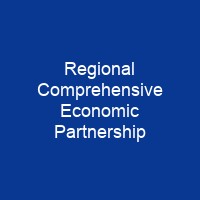The RCEP is a free trade agreement between 15 countries. The 15 member countries account for about 30% of the world’s population. The agreement is intended to reduce tariffs and red tape. According to a 2020 projection, the agreement is expected to increase the global economy by USD 186 billion USD.
About Regional Comprehensive Economic Partnership in brief

India pulled out of the deal in November 2019, primarily due to concerns of dumping of manufactured goods from China and agricultural and dairy products from Australia and New Zealand. According to a 2020 projection, the agreement is expected to increase the global economy by USD 186 billion USD. It will be bigger than both the United States–Mexico–Canada Agreement and the European Union.
You want to know more about Regional Comprehensive Economic Partnership?
This page is based on the article Regional Comprehensive Economic Partnership published in Wikipedia (as of Dec. 08, 2020) and was automatically summarized using artificial intelligence.







